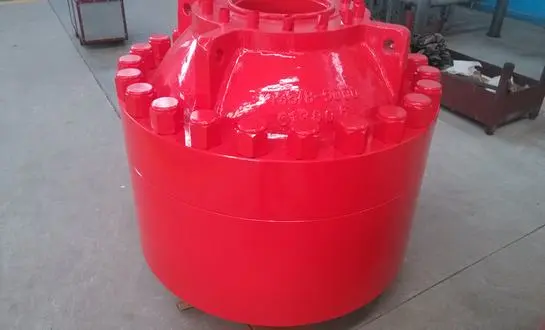Understanding Annular Blowout Preventers: Function and Importance
The Core Function of Annular Blowout Preventers
Annular Blowout Preventers are circular devices that surround the drill pipe and maintain a secure seal. Their primary function is to control wellbore pressure and prevent the uncontrolled release of formation fluids during drilling operations. The heart of an ABOP is its large, flexible rubber-like element known as the "packing element." When activated, this element is forced to close around the drill pipe, creating a pressure-tight seal that isolates the wellbore from potential blowouts.
Key Advantages of Annular Blowout Preventers
ABOPs offer several advantages that make them invaluable in drilling operations:
- Versatility: They can seal around different pipe sizes and irregular shapes, making them suitable for various drilling situations.
- Quick closure: The annular design allows for rapid closing and sealing, reducing response times during emergencies.
- Pressure management: ABOPs can withstand high pressures, contributing to effective well control during critical operations.
- Secondary seal: In cases of pipe movement or erosion, the secondary seal provides an extra layer of protection against wellbore leakage.
The Importance of ABOPs in Safe Drilling Operations
The importance of Annular Blowout Preventers in safe drilling operations cannot be overstated. They serve as a critical safety barrier, preventing potentially disastrous blowouts that could lead to loss of life, environmental damage, and significant financial losses. By maintaining wellbore integrity and controlling pressure, ABOPs allow drilling operations to proceed safely, even in high-pressure formations or challenging environments.
Types and Working Mechanism of Annular Blowout Preventers
Common Types of Annular Blowout Preventers
There are several types of Annular Blowout Preventers, each designed to meet specific operational requirements:
- Hydraulic Annular Blowout Preventer: This is the most widely used type, utilizing hydraulic pressure to close and seal around the drill pipe or casing. It offers precise control over the sealing force and is known for its reliability and versatility.
- Spherical Annular Blowout Preventer: These feature a spherical-shaped sealing element instead of the traditional doughnut-shaped one. The spherical design allows for a larger contact area, enhancing sealing effectiveness in demanding drilling environments.
Working Mechanism of Annular Blowout Preventers
The working mechanism of an ABOP involves several key steps:
- Activation: When activated, hydraulic pressure is applied to the closing chamber of the ABOP.
- Piston Movement: This pressure causes the piston to move upward, compressing the packing element.
- Sealing: As the packing element is compressed, it deforms inward, creating a tight seal around the drill pipe or open hole.
- Pressure Containment: The seal prevents the upward flow of wellbore fluids, effectively containing pressure within the well.
The closing pressure applied to the ABOP is crucial for its effective operation. Guidelines for closing pressures are provided by manufacturers and should be followed to ensure long life and optimal performance of the packing element.
Material Composition of Annular Blowout Preventers
The effectiveness of an ABOP largely depends on its material composition:
- Packing Element: This is typically made of elastomeric material, chosen for its ability to deform and create a tight seal.
- Reinforcement: To prevent extrusion under high pressures, metallic reinforcements are often molded into the packing element.
- Body: The body of the ABOP is usually made of high-strength steel to withstand the extreme pressures encountered during drilling operations.
The choice of materials is critical, as ABOPs are exposed to various drilling environments, including corrosive gases and high temperatures. Selecting the appropriate packing element for the anticipated drilling environment is crucial for optimal performance and longevity of the ABOP.
Maintenance and Best Practices for Annular Blowout Preventers
Regular Maintenance and Inspection
Proper maintenance of Annular Blowout Preventers is crucial for ensuring their reliability and effectiveness. Regular maintenance practices include:
- Visual Inspections: Regularly check for signs of wear, damage, or leaks in the ABOP components.
- Functional Testing: Conduct periodic tests to ensure the ABOP can open and close properly and maintain a seal under pressure.
- Packing Element Replacement: Replace the packing element according to manufacturer recommendations or when signs of wear are observed.
- Lubrication: Ensure all moving parts are properly lubricated to prevent friction and wear.
Best Practices for ABOP Operation
To maximize the effectiveness and lifespan of ABOPs, consider these best practices:
- Proper Closing Pressure: Always use the manufacturer-recommended closing pressure to avoid damaging the packing element.
- Environmental Considerations: Choose packing elements suitable for the specific drilling environment, considering factors like temperature and corrosive substances.
- Training: Ensure all personnel are properly trained in the operation and maintenance of ABOPs.
- Documentation: Keep detailed records of all maintenance activities, inspections, and tests performed on the ABOP.
Risk Assessment and Prevention
Implementing a comprehensive risk assessment strategy is essential for preventing ABOP failures:
- Conduct thorough risk assessments to identify potential failure points and vulnerabilities in the ABOP system.
- Develop and implement contingency plans for various failure scenarios.
- Regularly review and update safety protocols based on industry best practices and lessons learned from incidents.
- Invest in advanced monitoring systems to detect early signs of ABOP malfunction or deterioration.
By following these maintenance practices and operational guidelines, drilling operators can significantly enhance the reliability and effectiveness of their Annular Blowout Preventers, thereby improving overall safety in drilling operations.
Conclusion
Annular Blowout Preventers are indispensable components in modern drilling operations, playing a crucial role in maintaining well control and ensuring the safety of personnel and the environment. Their ability to seal around various pipe sizes and withstand high pressures makes them versatile and effective in a wide range of drilling scenarios. By understanding the types, working mechanisms, and maintenance requirements of ABOPs, drilling operators can maximize their effectiveness and minimize the risk of catastrophic blowouts. As the oil and gas industry continues to evolve, the importance of ABOPs in safe drilling operations remains paramount, underscoring the need for ongoing research, development, and adherence to best practices in their use and maintenance.
FAQ
1. What is the main purpose of an Annular Blowout Preventer?
The main purpose of an Annular Blowout Preventer is to seal the space around the drill pipe and control wellbore pressure during drilling operations. It prevents the uncontrolled release of formation fluids, ensuring safety and maintaining well integrity.
2. How often should Annular Blowout Preventers be inspected?
Annular Blowout Preventers should be inspected regularly, typically before each use and at intervals specified by the manufacturer or regulatory bodies. Many operators conduct daily visual inspections and perform more thorough functional tests weekly or monthly, depending on usage and regulations.
3. Can Annular Blowout Preventers seal around different pipe sizes?
Yes, one of the key advantages of Annular Blowout Preventers is their ability to seal around various pipe sizes and even irregular shapes. This versatility makes them suitable for a wide range of drilling operations and scenarios.
Experience the WELONG Advantage in Annular Blowout Preventers
At WELONG, we understand the critical role that Annular Blowout Preventers play in ensuring safe and efficient drilling operations. Our commitment to quality, innovation, and customer satisfaction sets us apart as a leading supplier in the industry. With our ISO 9001:2015 and API 7-1 certifications, you can trust that our ABOPs meet the highest standards of quality and reliability.
Experience the WELONG difference with our comprehensive range of oilfield products, including top-of-the-line Annular Blowout Preventers. Our team of experts is ready to assist you in finding the perfect solution for your drilling needs. Don't compromise on safety and efficiency – choose WELONG for your Annular Blowout Preventer requirements.
Ready to enhance your drilling operations with industry-leading Annular Blowout Preventers? Contact our team of experts today at oiltools15@welongpost.com to discuss your specific needs and discover how WELONG can be your trusted Annular Blowout Preventers supplier.
References
- Smith, J. R. (2021). "Advanced Well Control Techniques: The Role of Annular Blowout Preventers." Journal of Petroleum Engineering, 45(3), 287-301.
- Johnson, A. L., & Thompson, R. K. (2020). "Maintenance Strategies for Annular Blowout Preventers in Deepwater Drilling." Offshore Technology Conference Proceedings, OTC-30456-MS.
- Williams, S. T., et al. (2019). "Comparative Analysis of Hydraulic and Spherical Annular Blowout Preventers." SPE Drilling & Completion, 34(2), 145-158.
- Brown, M. E. (2022). "Safety Innovations in Blowout Prevention: A Review of Annular BOP Technologies." International Journal of Oil, Gas and Coal Technology, 29(4), 401-415.
- Davis, C. H., & Martinez, L. R. (2020). "Material Advancements in Annular Blowout Preventer Design." Materials Science and Engineering: A, 795, 140023.
- Anderson, P. K., et al. (2021). "Risk Assessment Methodologies for Annular Blowout Preventer Failures in Offshore Drilling." Reliability Engineering & System Safety, 215, 107862.





